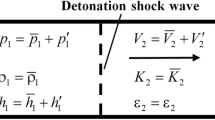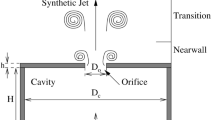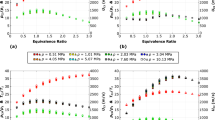Abstract
Early works on the detonation driven shock tube are reviewed briefly. High initial pressure detonable mixture can be used in backward-detonation driver when the buffer tube is attached to the end of the driver for eliminating the excessive reflected peak pressure. Experimental data showed that an improvement on attenuation of the incident shock wave generated by the forward driver can be obtained, provided the diameter of the driver is larger than that of the driven section and an abrupt reduction of cross-section area is placed just beyond the diaphragm. Also, it is clearly verified by a numerical analysis. An additional backward-detonation driver is proposed to attach to the primary detonation driver and on condition that the ratios of initial pressure in the additional driver to that in the primary driver exceed the threshold value, the Taylor wave behind detonation wave in the primary detonation driver can be eliminated completely.
Similar content being viewed by others
References
Hertzberg A., Smith W.E.(1954): A method for generation strong shock waves. J. Appl. Phys. 25, 130
Bird G.A.(1957): A note on combustion driven shock tubes, R.A.E TN-Aero 2511, RAE. Farnborough, England
Waldron, H.F.: An experimental investigation of the flow properties behind strong shock wases in nitrogen, UTIA Report, No.50 (1958)
Balcargak, M., Johnson, M.R.: The gaseous-detonation driver and its application to shock tube simulation technigues.In: Proceedings of 5th International Shock Tube Symposium, pp. 1111–1128, White Oak, Maryland (1996)
Yu, H.R.: Shock tunnel and its application to aeroheating experiments, Thesis, Institute of Mechanics, Chinese Academy of Sciences (In Chinese) (1963)
Edwards D.H., Williams G.T., Breege J.C.(1959): Pressure and velocity measurements on detonation waves in hydro-oxygen mixtures. J. Fluid Mech. 6, 497–517
Yu, H.R.: Recent developments in shock tube application. In: Takayama, K. (ed.) Proceedings of 1989 National Symposium on Shock Wave Phenomena, Sendai, Tohoku University (1989)
Yu H.R., Esser B., Lenartz M., Groenig H.(1992) : Gaseous detonation driver for a shock tunnel. Shock Waves 2(4): 245–254
Yu, H.R., Zhao, W.: The use of oxy-hydrogen detonation driver for generator of high enthalpy flow. In: Shen, C. (ed.) Proceeding 20th International Symposium on Rarefied Gasdynamic, pp. 927–933 (1997)
Lu, F.K., Marren, D.E.: Advanced hypersonic test facilities. Progress in Astronautics and Aeronautics, vol. 198, AIAA, Virginia, pp. 137 (2002)
Nettleton M.A.(1987) : Gaseous detonation. Chapman and Hall, London
Yu H.R.(1999): Oxy-hydrogen combustion and detonation driven shock tube. Acta Mech. Sin. 15(2): 97–107
Fuehrer, R.G.: Measurements of incident shock test time and reflected shock pressure at full turbulent boundary layer test conditions. In: Glass, II. (ed.) Shock Tubes. University Toronto press, pp. 31–59 (1970)
Taylor G.I.(1950): The dynamics of the combustion products behind planar and spherical detonation fronts in explosive. Proc. R. Soc. (London) A 200, 235–247
Alpher R.A., White D.R.(1958): Flow in shock tubes with area change at diaphragm section. J. Fluid. Mech. 8:457
Yang H.W., Huang D., Yu H.R.(2005): Numerical simulation of the behavior of a variable cross-section forward-detonation driven shock tube. Acta Mechanica Sinica (In Chinese), 37(4): 491–500
Jiang, Z.L., Yu, H.R., Takayama, K.: Investigation into converging gaseous detonation driver. In: Proceedings of 22nd ISSW, London (1999)
Jiang Z.L., Zhao W., Wang C., Takayama K.(2002): Forward-running detonation driver for high-enthalpy shock tunnels. AIAA J. 40(10): 2009–2016
Coates D.H., Gaydon F.R.S.(1965): A simple tube with detonating driver gas. Proc. R. Soc (London) A 283, 18–32
Bakos, R.J., Calleja, J.F., Erdos, J.I.: An experimental and computational study leading to new test capabilities for the HYPULSE facility with a detonation driver. AIAA 96–2193 (1996)
Chen H., Feng H., Yu H.R.(2004): Double detonation drivers for a shock tube/tunnel, Science in China. Ser. G 47(4): 502–512
Author information
Authors and Affiliations
Corresponding author
Additional information
Communicated by K. Takayama.
Rights and permissions
About this article
Cite this article
Yu, H.R., Chen, H. & Zhao, W. Advances in detonation driving techniques for a shock tube/tunnel. Shock Waves 15, 399–405 (2006). https://doi.org/10.1007/s00193-006-0041-2
Received:
Accepted:
Published:
Issue Date:
DOI: https://doi.org/10.1007/s00193-006-0041-2




